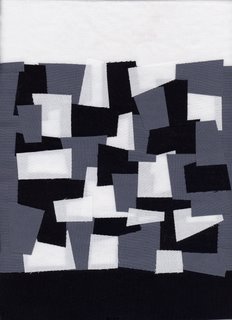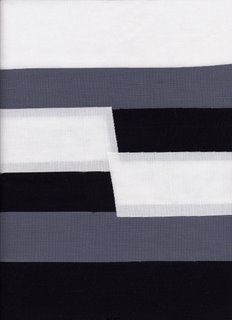Color Study 1: Achromatic
Addendum, July 22, 2006: Hi everyone! I’ve added a link on the sidebar to this post, which is the first of an extended series of tutorials on color. If you’d like to read the rest of the series, look in the sidebar to the right that says “Archives.” Click on February 2006, the scroll down to the 17th. Read from the bottom up to follow the posts in sequence. Thanks and cheers!
OK…you guys (presuming rashly that anyone is reading!) get to be my guinea pigs. This is the first of 9 or 10 posts in a series on color. I’d love feedback, so please read on!
Background: last fall I gave a talk for my local guild chapter, then a paid lecture for the Clamshell Quilters down the road a piece in Damariscotta, on Color for Quilters. I think the talks went reasonably well, and I was able to illustrate most of the concepts with my quilts, from journal to large wall sized. But, I decided what I really needed was some “show and tell” specifically geared to teaching quilters basic color theory. So…….I decided to make a series of two-sided journal quilts to illustrate various concepts. Just to get you reading, I’m putting one quiltlet here, but read below for details.
I started the talks like this:
Learning about color is a lot like learning about quilting. You need to learn the words so that you can understand what people are saying. How many of you know what a fat quarter is? (Virtually every hand in the room is raised.) How many of you know what a scant quarter inch means? (Ditto) And if I say a log cabin, do you think of a building in the woods, or a quilt? (guess what…) What about a Baltimore Album. I’m guessing folks are not thinking of a black vinyl disc played on an antique known as a record player. And I’m guessing they’re also not thinking about a photo album. We have all learned the words to explain quilty things.
Well, it’s the same thing for understanding color. If we define the words and illustrate them, including interpreting them in cloth, then they are easier to understand.
This post is about the first term: achromatic, which means without color or, more simply, black, white and shades of gray—something that lacks color. This photo is the back of the quilt (which isn’t actually quilted, yet…stay tuned!): And the photo at the start of the post is a simple assortment of the black, white and gray sorta-square shapes. I decided to put white borders on the tops of all the pieces, black on the bottom, and tuck grey into the center portion to illustrate the effect of placing a “color” (or lack thereof) next to black, white and gray. You’ll see in future posts how the gray seems dark when placed next to yellow, but light next to dark violet. It’s the same gray in all of them…..
And the photo at the start of the post is a simple assortment of the black, white and gray sorta-square shapes. I decided to put white borders on the tops of all the pieces, black on the bottom, and tuck grey into the center portion to illustrate the effect of placing a “color” (or lack thereof) next to black, white and gray. You’ll see in future posts how the gray seems dark when placed next to yellow, but light next to dark violet. It’s the same gray in all of them…..
Anyway, I’d really appreciate feedback on these pieces as teaching tools. Stay tuned, keep reading, and let me know what you think. I want also to teach folks about using thread to manipulate the appearance of the color of fabric…more on that down the line.

February 17th, 2006 at 7:25 pm
Looking good so far, Sarah. I’ll be interested to see what you come up with next.
February 18th, 2006 at 2:24 am
I find the 1st photo distracting because I’m looking at the shapes. The 2nd photo is easier if you are just talking about colour or the lack of it
February 18th, 2006 at 5:01 am
there are a lot of people out there who will benefit from your down to earth way of explaining theory (very understandable)! it is fascinating how one color can change when put beside another. Looking forward to the next installment.
February 18th, 2006 at 8:09 am
oo.. this is a brilliant idea for a series to illustrate a point. will enjoy watching for the other examples.
February 18th, 2006 at 12:28 pm
This was very easy to understand for me. Speech sounds do the same thing. Consonants change depending upon the vowel phoneme that follows it.IE
Cot/coddle/calm (though spelled differently the same sound).
Looking forward to the next installment.
September 12th, 2006 at 8:14 am
I have never posted before but just had to let you know how much your effort is appreciated. You have a wonderful teaching strategy. Look forward to future installments.